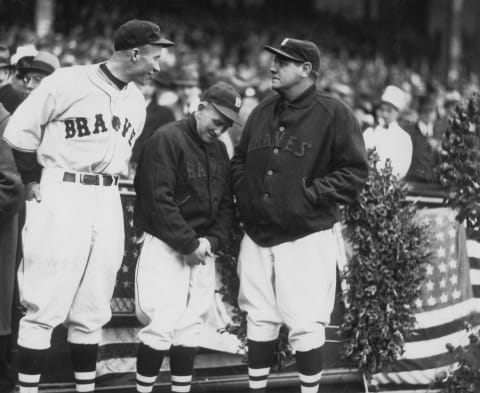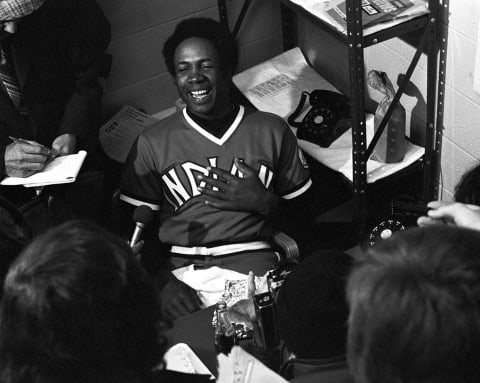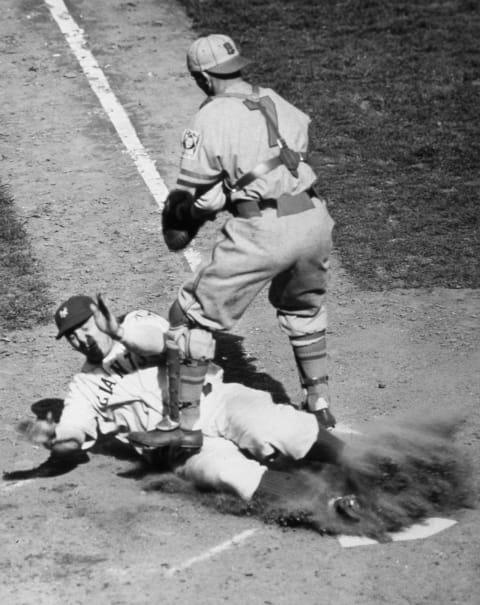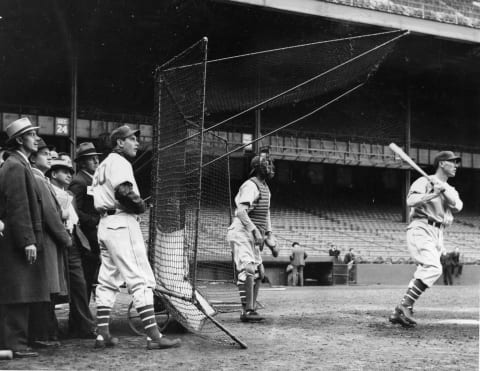Atlanta Braves franchise best outfielders: No. 4 Wally Berger


In 2018 Atlanta Braves fans watched as a rookie outfielder took the league by storm just as Boston Braves fans did 88 years earlier.
Ask an average Atlanta Braves fan to name a player from the 1930s Boston Braves roster, and they might say, Rabbit Maranville or Babe Ruth, who played for 46 days in 1935. But it’s more likely you get a blank look.
He isn’t as famous as others who played for the franchise, but in his day, he was the best in the National League.
Walter Alton Wally Berger patrolled centerfield in cavernous Braves Field for seven years and 30 games, as the Braves (later the Bees) won more than 78 games once. The club was so mind-numbingly bad in 1935 that they managed only 38 victories and a .248 winning percentage.
As a result, he’s also the first player on the outfield list without a postseason game for the franchise.
None of that is Berger’s fault; he was a superstar before the word existed, setting rookie home run and RBI records that stood in the NL for seven decades. He was a perennial MVP and All-Star caliber player.
After signing in 1927, Berger batted .382 with a .670 slugging rate between C-ball and AA. In 1928 he hit 20 homers, batted .327, and slugged .528 for the AA Angels of Los Angels and followed that with a 40 homer season batting .335 and slugging .565.
He was a force in the Pacific Coast league in 1929, swatting 40 long balls for the Angels of Los Angeles, and he carried his West Coast success to the east, banging out 38 long balls as a freshman.
Wally led NL left fielders with 38 homers and 119 RBI as a rookie while also hitting a lusty .310 with a .614 slugging percentage.
The 1929 Boston Braves as a team – 43 players – hit just 33 homers, and one of those came from pitcher Bob Smith. So, the Braves sent him a ticket to Boston in time for the 1930 season.
Before going further, it’s worth moving sideways a bit to talk about Braves Field in Boston.

The effect of Braves Field
When Braves Field opened, J.C. O’Leary, writing for the Boston Globe, called it the finest baseball park in the world. If nothing else, it was big, as in massive. The foul line makers read 375 feet, dead-center was 440 feet and the fence in right-center was 520 feet away.
Related Story. Tommy can you see me. light
Braves Field was always an awful place to hit home runs. Clem’s Baseball Blog gives details. I added links to images from Digital Ballparks to the quotes to try to show what he described
In almost every year from the late 1920s until the early 1940s, the outfield dimensions changed, but much uncertainty remains over the exact sequence of these changes . . . . . . there was usually a strong wind blowing in from center field, making it very hard to hit the ball very far. . . . the stadium was situated rather close to the Charles River, which was a sort of funnel for ocean breezes . . . . . . (it sat) right next to a major railroad switching yard. . . smoke from the locomotives often clouded the field, so they planted a row of fir trees to block this unsightliness, to little avail . .
After Babe Ruth made home runs popular, the club moved the fences in but found other teams hitting more homers than the Braves, so they moved them back.
Records are non-existent, so we don’t know precisely when that happened, but references indicate both moves occurred before 1930.
We do know the one-year park factors for Braves’ field and that it ranked in the bottom three in the league nine times in 14 years.
| Year | PF | Rank | Year | PF | Rank |
| 1923 | 101 | 7 | 1930 | 96 | T 11 |
| 1924 | 96 | 14 | 1931 | 99 | 9 |
| 1925 | 94 | 16 | 1932 | 92 | 15 |
| 1926 | 87 | 16 | 1933 | 94 | T 13 |
| 1927 | 95 | 16 | 1934 | 86 | 16 |
| 1928 | 101 | 5 | 1935 | 99 | 8 |
| 1929 | 95 | 16 | 1936 | 94 | 15 |

Boston’s big Berger
If the Rookie of the Year Award had existed in 1930, Wally Berger’s record would show he won. He exploded onto the National League stage, much like Ronald Acuna Jr. for the Atlanta Braves in 2018 — minus the stolen bases.
In Harold Kaese’s book The Boston Braves, he describes Berger as a “lanky, raw-boned blond, a free-swinging young giant.” At 6-foot-2 and 198 pounds, Berger was tall for the time and proved himself a giant in centerfield and at the plate.
On September 17, in the Braves 30th doubleheader of the year and sixth in the homestand. Berger went 5-for-8 in the twin-bill, with three home runs, a double, seven RBI, and three runs scored, bringing his total for the year to 37 homers and 116 RBI.
When the season ended, Berger had batted 310/.375/.614/.990, good for a 137 OPS+, hit a Major League rookie record 38 homers, drove in an NL rookie record 119 runs. Fangraphs retrospectively make that a 4.5 fWAR season with a .422 wOBA, and 131 wRC+.
At that time, his .990 OPS as a rookie ranked second all-time among qualified players in the live-ball era (post-1918) and ranks sixth all-time today.
Frank Robinson tied Berger’s rookie home run record in 1956, but their joint record stood until Mark McGwire hit 49 homers in 1987. Berger retained the NL rookie RBI record until Albert Pujols drove in 130 runs 71-years later in 2001.
Pete Alonso budged Berger into third place on the NL list when he drove in 120 runs in 2019; it took Alonso 10 more games and 42 more PA than Berger to grab second.
In 1931 Berger’s average climbed to .323, and his on-base rose to .380, but his power numbers dipped to 19.
We don’t know why, but it’s likely tied to Braves’ Field. Data from Baseball-Reference.com shows that home runs dropped off for everyone, including teams visiting the Braves in both 1931 and 1932.
His drop in home runs aside, Berger’s 1931 was good for 6.0 rWAR, 6.2 fWAR, a .404 wOBA, and 141 wRC+. He followed that with a 4.0 rWAR, 4.1 fWAR, .365 wOBA, and 122 wRC+, and a 13th place finish in NL MVP voting in 1932.
MLB’s first All-Star game took place in 1933 and Wally Berger started in centerfield. He repeated that start for the next three seasons. Atlanta Braves centerfielder Andruw Jones started five All-Star games, but never more than two in a row.
The Braves finished the season in fourth place with an 83-71 record, their first 80-win season since 1916, and the first time above 79 wins since 1921, thanks to Berger.
He ended the 1933 season with 27 home runs, 106 RBI, a .566 slugging rate, a .932 OPS, and a 172 OPS plus, all ranked second in NL.
Fangraphs made that his best year in Boston, worth 6.4 fWAR, a .419 wOBA, and 168 wRC+, while BBR called it a 7.0 rWAR season. Baseball writers were impressed as well, giving the Braves’ centerfielder a third-place finish in MVP voting.

Take this ball club, please
Berger did his best to carry Boston over the next two seasons, sacrificing average for power in the process. His 34 homers in 1934 were second behind Ripper Collins and Mel Ott, who both notched 35. Berger finished 16th in MVP voting, and Boston finished in fourth again 78-73.
Berger duplicated his 34 homers in 1935, reclaiming the home run title from Ott and led the league with 130 RBI.
He continued to bang-out doubles as well, consistently hitting 34 or more every year and 39 in 1935. Sadly, Berger’s doubles total was one greater than the number of games the Braves won; they finished the season 38-115, the second-worst winning percentage in baseball since the American Association merged with the NL in 1892.
The Braves signed Ruth in 1935, falsely promising he’d eventually become a manager when the real purpose was to bring fans to the ballpark. Ruth didn’t last two months, but the fans who came to the park gave them a $20,000 profit.
Owner Emil Fuchs owed Charles Adams more money than he had or could raise. Adams owned a chain of grocery stores and acted as Braves’ VP, but didn’t care about the team. On August 1, Fuchs resigned, dumping the team in Adams’ lap.
He looked for a buyer and thought the owner of the Boston Braves NFL team (now the Redskins) would take it, but the money never appeared, and when the season ended, the baseball Braves were broke. After weeks of stumbling around, NL President Ford Frick announced the league would run the franchise. But, no, legal issues arose that prevented that from happening.
Eventually, the league sold the team to Bob Quinn who made a lot of bad decisions, including renaming the team the Boston Bees.
Berger keeps buzzing
Berger has another good season as a Bee but missed his All-Star game start due to a shoulder and hand injury that meant he played only 138 games. Even with a gimpy arm, he batted .288/.361/.483/.844 posted a 132 OPS+, hit 25 homers, drove in 91 runs, and finished 16th in MVP voting.
The Bees improved to 71 and 83, an impressive 33-game jump from their disastrous 1936 campaign.
Over the seven full seasons Berger played for Boston, he delivered nearly half the home runs hit at home by the Braves, just under 35 percent of the homers hit on the road, and 43.9 percent overall.
| Year | Team | Berger | Allowed | |
| 1930 | Home | 29 | 18 | 51 |
| Away | 37 | 20 | 66 | |
| 1931 | Home | 16 | 7 | 24 |
| Away | 18 | 12 | 42 | |
| 1932 | Home | 27 | 10 | 20 |
| Away | 36 | 7 | 41 | |
| 1933 | Home | 27 | 16 | 26 |
| Away | 27 | 11 | 28 | |
| 1934 | Home | 36 | 15 | 28 |
| Away | 47 | 19 | 50 | |
| 1935 | Home | 34 | 18 | 41 |
| Away | 41 | 16 | 40 | |
| 1936 | Home | 26 | 14 | 23 |
| Away | 41 | 11 | 46 | |
| Totals | Home | 195 | 98 | 49.5% |
| Away | 247 | 96 | 34.8% |
In 2019 the Atlanta Braves hit 249 homers – 131 at home and 118 on the road – two more than the Boston Braves hit on the road from 1930 to 1936.
Thirty games into the 1937 season, the Bees traded Berger to the Giants for Frank Gabler and $35,000.
As a Brave, Berger’s numbers are impressive, particularly playing for an awful baseball team.
| BA | OBP | SLG | OPS | AVG+ | OBP+ | SLG+ | wRC+ | wOBA | WAR | fWAR |
| .304 | .362 | .533 | .894 | 106 | 105 | 130 | 139 | .398 | 36.6 | 36.9 |

Epilogue
The trade to New York worked out well for Berger; he no longer had to face the devastating screw-ball of King Carl Hubble, and he played in his first World Series.
The Giants outfield of Ott, Jimmy Ripple, and Jo-Jo Moore hit and defended well, but Berger got time when Ripple had a day off. He got only three PA in the series, but earned a full share of the losers split, as the Yankees took the series in five games
The Giants traded him to the Reds in June of 1938 and he saw action with the Reds in the 1939 World Series loss to the Yankees but went hitless in 15 PA. The Reds released him May 10 of 1940. He hooked up with the Phillies, but they released him in July.
Berger joined the Navy in 1942 and served as baseball coach at the Naval Air Training Station in San Diego until 1945
In the introduction to Berger’s book Freshly Remember’d, George Morris Snyder summed up his career in Boston like this.
, , , he played in a ‘pitchers park’ with a team that never came close to winning all the marbles. It was a club out of the mainstream . . .inadequately financed, poorly administered, and usually overmatched on the field. Despite all this, the Braves were always an interesting team,. . . And for seven seasons their most brilliant, courageous, and persevering player was Walter Anton Berger.
Wally Berger died November 30, 1988, in Redondo Beach, Calif.
That’s a wrap
In looking for a comp, my first thought was Jim Edmonds, and for the first seven-plus seasons, their careers align pretty well. Berger’s similarity scores highlighted two players Atlanta Braves fans know well.
Berger didn’t play long enough for Hall of Fame consideration, but his statistics otherwise are certainly worthy. Given a younger start, better health, and a better team, who knows what happens?
At 24-years old, Baseball-Reference compares him to former Braves first baseman/outfielder Ryan Klesko. However, overall the eighth-most similar player is Freddie Freeman.
Baseball-Reference bases similarity scores on games played and other statistics, but when I saw the comp, it made sense for different reasons. Berger was tall, blonde, and Snyder described him as:
. . . modest, quiet, hard-working, conscientious, and disciplined. He didn’t kick dirt on umpires, become engaged in scandal, or engage in wacky behavior. He didn’t make good copy for the boys in the press box . . . And for seven seasons their most brilliant, courageous, and persevering player . . .
Next. The Braves fifth-ranked OF. dark
It sounds like Wally would fit the current roster pretty well.